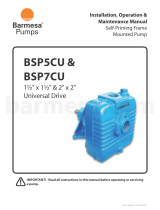
1
Before installation, read the following
instructions carefully. Failure to
follow instruction and safety
information could cause serious
bodily injury, death and/or property
damage. Each Barmesa product is
carefully inspected to insure proper
performance. Closely following these
instructions will eliminate potential
operating problems, assuring years
of trouble-free service.
General Safety Information
IMPORTANT! - Barmesa Pumps is not
responsible for losses, injury or
death resulting from failure to
observe these safety precautions,
misuse, abuse or misapplication of
pumps or equipment.
B r o n z e / b r a s s f i t t e d
pumps may contain levels higher than
considered safe for potable water systems.
Government agencies have determined
that leaded copper alloys should not be
used in potable water applications.
WARNING
I n s t a l l a t i o n a n d
servicing is to be conducted by
qualified personnel only.
WARNING
D o n o t u s e t h e s e
pumps in water over 104º F. Do not
exceed manufacturers recommended
maximum performance, as this could
cause the motor to overheat.
WARNING
A L L R E T U R N E D
P R O D U C T S M U S T B E
CLEANED, SANITIZED, OR
DE CON TA MIN AT ED P R IOR TO
S H I P M E N T , T O I N S U R E
E M P L O Y E E S W I L L N O T B E
EXPOSED TO HEALTH HAZARDS IN
HANDLING SAID MATERIAL. ALL
A P P L I C A B L E L A W S A N D
RE GU LAT I ON S S HAL L A P PLY.
Keep clear of suction and
discharge openings. Do not
insert fingers in pump with
power connected; the rotating cutter
and/or impeller can cause serious
injury.
Always wear eye protection
when working on pumps. Do
not wear loose clothing that
may become entangled in moving
parts.
Pumps build up heat
and pressure during
operation. Allow time
fo r p u mp s t o c o ol
DANGER
before handling or servicing the
p u mp o r a n y a cc es s o r y i te ms
associated with or near the pump.
T h i s p u m p i s n o t
i n t e n d e d f o r u s e i n
swimming pools or water
installations where there is
DANGER
human contact with pumped fluid.
Risk of electric shock. To
reduce risk of electric shock,
always disconnect pump
from power source before
DANGER
handling. Lock out power and tag.
Do not lift, carry or
hang pump by the electrical
c a b l e s. D a m a ge t o t h e
electrical cables can cause
DANGER
shock, burns or death. Never handle
connected power cords with wet
hands. Use appropriate lifting device.
S u m p a n d s e w a g e
pumps often handle materials which
could cause illness or disease. Wear
adequate protective clothing when
working on a used pump or piping.
Never enter a basin after it has been
used.
WARNING
Failure to permanently
ground the pump, motor and
controls before connecting
to power can cause shock,
DANGER
burns or death.
These pumps are not to
be installed in locations
classified as hazardous in
accordance with the National
Electric Code, ANSI/NFPA 70.
DANGER
Do not introduce into
any sewer, either directly, or through a
kitchen waste disposal unit or toilet:
seafood shells, aquarium gravel, cat
litter, plastic objects (toys, utensils, etc.),
sanitary napkins or tampons, diapers,
rags, disposable wipes or cloth,
medications, flammable material, oil or
grease, strong chemicals, gasoline.
WARNING
WARNING
"Danger" indicates an
imminently hazardous situation
which, if not avoided, WILL result in
death or serious injury.
"Warning" indicates
an imminenty hazardous situation
which, if not avoided, MAY result in
death or serious injury.
"Caution" indicates a
potentially hazardous situation
which, if not avoided, MAY result in
minor or moderate injury.
DANGER
CAUTION
Installation, wiring, and
ju n c t i o n co n n e c t i ons m u s t b e i n
accordance with the National Electric
Code and all applicable state and local
codes. Requirements may vary depending
on usage and location.
WARNING
1 Phase Models
Amps: Volts:
3 Phase Models
Amps L1-2: Volts L1-2:
Amps L2-3: Volts L2-3:
Amps L3-1: Volts L3-1:
Model Number: _____________________
Serial: ____________
PHASE: ______ HP: ________________ __
IMPORTANT! - Prior to installation,
record Model Number, Serial, Amps,
Voltage, Phase and HP from pump
name plate for the future reference.
Also record the Voltage and Current
Readings at Startup:
barmesa.com





















